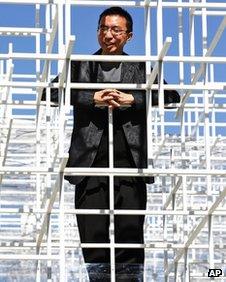'Seductive' Serpentine Pavilion reviewed
- Published
Sou Fujimoto is the youngest architect to accept the commission
The Serpentine Gallery in London will open its annual Pavilion commission to the public this weekend.
Sou Fujimoto is the youngest architect to design a temporary structure for the gallery in Kensington Gardens.
The Japanese architect, 41, follows in the footsteps of such past Pavilion designers as Ai Weiwei and Frank Gehry.
Reviewers have described the structure - a steel lattice that resembles a large white climbing frame - as "radical" and "seductive".
Visitors are encouraged to enter and interact with the Pavilion, which occupies 357 square metres of lawn outside the gallery.
The Pavilion will open on 8 June and remains open until 20 October.
Jay Merrick of The Independent describes the pavilion as "ambiguous, external".

His structure resembles a large white climbing frame
"It looks finished and unfinished, delicate and substantial, hard-edged and softly indistinct," he writes.
"Fujimoto has created a seductive maze of perspectives that lead your gaze into the structure and then, very teasingly, turns apparently strict structural order into impossible visual riddles."
The Guardian's architecture and design writer says Fujimoto's cloud symbolises "a powerful distillation of a young architect's ideas" and is "one of the most radical pavilions to date".
According to Oliver Wainwright, external, however, the result is "somewhat deflated when it meets the real world".
Speaking to the London Evening Standard, Serpentine director Julia Peyton-Jones said Fujimoto's structure was "a really remarkable thing, external".
"It's a kind of digital cloud, a very visible mass floating in the atmosphere," she added.
Fellow director Hans Ulrich Obrist described the pavilion as an "oscillation between the finished and unfinished, the organic and the geometric".
The gallery, he told Architects Journal, external, looked to "bring architects to this country of all generations".
The Pavilion will open on 8 June and is free to visit until 20 October.
- Published9 May 2012